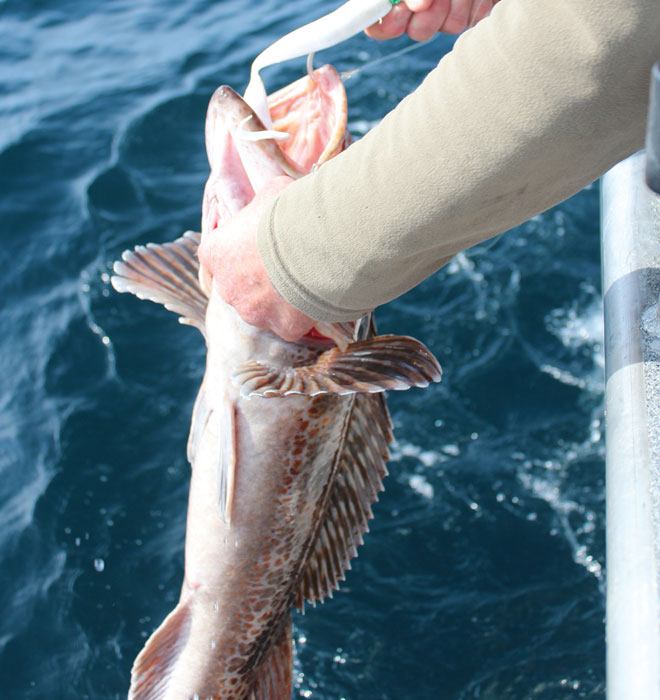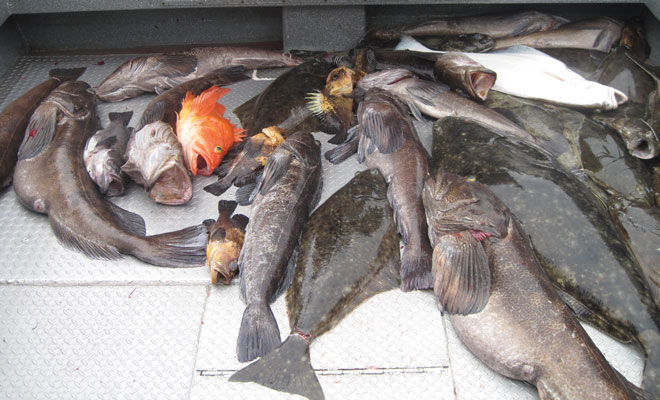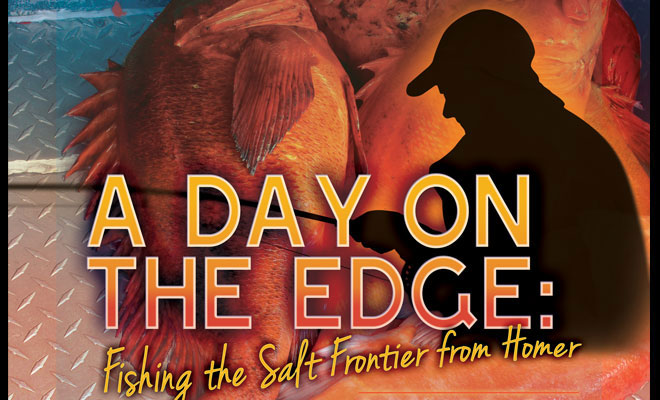A Day on the Salt
Fishing the Salt Frontier from Homer
Story & Photos by Steve Meyer
The rhythm of the waves pounded the bow of the aluminum boat before it came to a stop, and I braced myself for the crash, which came seconds later as we fell into a swell trough and salt spray washed over the back deck where I was standing. Leaving Homer harbor that morning the water looked calm and promised a pleasant boat ride over the 80 miles to our destination off the coast of Gore Point, the very edge of saltwater fishing off the Kenai Peninsula. But there is no guarantee of fair weather, and the inevitable black line that signals rough water was prominent on the horizon 20 miles out of the harbor heading southwest, where Kachemak Bay and Cook Inlet collide.
Going through this stretch when the water is rough has been known to inspire a Hail Mary or two. A sensible person might go into the cabin for the 15- to 20 minutes it usually takes to get through the area, but there is also something about being out in the salt air and feeling the bone-jarring slams that is life-affirming. Our captain, Tim Erion, a 20-year veteran of these waters, sat at the helm and continued to entertain his clients, who remained in the cabin, with humorous stories andfabulous memories of the life he has lived in this magnificent place, seemingly oblivious to the water, while I was determined to enjoy every blow the ocean was serving on the deck.
There were six clients onboard on this early July morning, a full boat being a necessity on these distant trips. Running time is six- to seven hours for the day, a lot of expensive fuel and inevitably meaning at least a 12-hour day on the water. Three of the original crew for this trip had things come up and so there were two distinctly separate groups onboard, which is normal for charter boats and typically not an issue. Everyone shares the common ground of a love of fishing and oftentimes become fast friends by the end of the day. This was a bit different only in that the original fishermen had intended the trip to be a light-tackle/fly-fishing endeavor for black rockfish, lingcod, yelloweye, and quillbacks. The trip was going to be about the fun of bringing in these gorgeous predators from the deep with not a care in the world for filling the fish box. That is a rare crew to come by and the three newcomers were all about getting big halibut, big lingcod and big whatever else we could catch to fill the freezer. And really, who could blame them: $300 per head is a lot of money and a big cooler of fillets at the end of the day eases the wound in the pocketbook remarkably well.
Even so, the only guarantee when you head into the very frontier of the fishing world, I thought to myself as we pounded our way south, is that it will be grand if you let it. Shortly thereafter, as we passed the southern end of Flat Island, a dozen or more Stellar sea lions beached on the shore rewarded us with their presence. Mt. Augustine, an active volcano, loomed off to the west where it stands in the surrounding water, a sentinel to the entrance of Cook Inlet. A ways farther there were two mountain goats down nearly to sea level on the rock cliffs that border some of the waters going through Chugach Passage. The coastline of the Chugach Islands on the west are alive with birds of all sorts and the waters themselves are prolific with sea otters, killer whales, seals and even the occasional pod of dolphins. In other words, the long trip to the fishing grounds becomes a short trip as you look forward to what the next horizon will bring.
Off the coast of Port Dick the captain slowed the big boat and stared intently at the depth sounder as he started barking orders to the deckhand. Tim doesn’t waste time; if the lines are not in the water no one is catching anything. He announced there would be halibut and perhaps some lingcod on the lee side of a drop-off that the tide was feeding. If you’ve never been out on a boat in deep (225-foot) water with a tide that ranks among the world’s fastest and with multiple lines going into the water, try to keep your perspective as the captain hollers orders for the choreographed dance that has to be accomplished just right. If not, the force of the tide and the accompanying crosscurrents will quickly tangle lines. Having to reel and untangle takes fishing time, and Tim is a master at reading the lines going into the water, directing the traffic.

A cod comes to hand.
As the third line started down, the angler on the second line reared back and set the hook of the 24-ounce, white curly-tailed jig into what was clearly a halibut. As the 50-pound ’but neared the surface, another flatfish hit the first line down and the next fight started as the first was ending. Immediately after that 40-pound halibut was safely ensconced in the fish hold, Tim hollered to reel in. Knowing half the boat was there forthe rockfish more than anything, Tim would drift over the flat a few times, get the meat anglers their limit of halibut and then move into shallower water with more rock pinnacles where the rockfish and lingcod hang out. It took about 90 minutes and a good share of that was eaten up by one of my partners who hooked a really good halibut, easily over the 100-pound mark, on his relatively light rockfish setup. With rod bent double, his feverish efforts to master the big fish had everyone mesmerized. But it was not to be—after finally getting the big fish to the surface, one hard headshake broke the line and the old girl headed back to the depths. No matter, he had a great fight and would have released the big female to go make more halibut anyway.
Crossing Kennedy Entrance toward the northern side of Port Dick we continued to enjoy the relative calm of the day. When I say relative what I mean is, not too choppy or windy. Out this far and being right on the edge of the Gulf of Alaska, the water is always big. Swells roll through that threaten to swallow the boat, which in a moment can seem very small. But we had been blessed with a clear, sunny day, and in July in Alaska, with the warmth of the sun reflecting from the water, it never seems too rough. Funny how the very same water on a dark and foreboding day clenches up the jaw muscles and gives rise to speculation for the seemingly very distant future.
In good time we were cruising near the rock cliffs marking the shoreline, the true home of rockfish. Tim was attempting to locate a surface feed of “black bass,” which are really not bass at all but rather a species of rockfish that has inherited the title from anglers over the years. They are pelagic, which is important in a couple of regards. One, the limit on pelagic rockfish is five per day; and two, pelagic rockfish can be encountered anywhere in the water column. Yelloweye, or “red snapper” as they are sometimes referred to, are a non-pelagic rockfish that live and feed on the bottom and the limit is one per day. Non-pelagic rockfish are longer lived and more susceptible to overharvest than their pelagic cousins.
On this day, the black bass were not boiling the surface as we have seen them so often before. But there were some at a depth of 20 feet and within reach of my 8-weight fly rod with fast-sinking line and a one-ounce jig. The three seconds it took for one of these voracious feeders to take the jig was typical of fish in these waters. It seems they are all starving to death and all one need do is get something that resembles protein in front of them and they take it. Looking around the boat before casting the jig again revealed four rods bent under the strain of black rockfish fighting for their freedom. The next fish hit harder and felt like a good-sized silver salmon; he stripped some line, and I fought him back for it and then he stripped it again. The third attempt to bring him to hand was successful, revealing a nice 9-pound example of the rockfish species. Fishing these predators of the deep with light tackle, gear that gives the fish a decent chance of freeing itself, is a great way to spend time on the water.
The tackle requirements for spinning, baitcasting or fly fishing these black rockfish is not much different than a setup for sockeye, or silver salmon. Pick the outfit according to how much you are willing to sacrifice the catch for the pure fight. If lingcod will be the focus, then weighing toward the king salmon setup will serve you better. You will want a sinking fly line regardless of the weight you choose. When the black rockfish are on the surface a large streamer or popper will draw plenty of attention and get hit before it has time to sink. But most times, the fish will be down at least 20 feet and sometimes much deeper. If lingcod and yelloweye are the target you’ll be fishing anywhere from60 feet down to 120 feet. In saltwater, even sinking lines will not go down rapidly and you’ll end up using some heavier jigs in order to get where the fish live. For going deep with a fly rod, I tried using lead-core line for backing and it works real well. Keep in mind, this isn’t like fly fishing for bonefish in the Florida Keys; there is very little finesse but there are a hell of a lot of hookups that are guaranteed to satisfy.
As an aside, a question that often surfaces when taking folks out for this sort of rockfish-centric trip is: Are they good to eat? Yes…and no. Grilled fresh off the boat black rockfish are as good as any of the fish out there. Properly packed and frozen (read that vacuum-sealed) they remain very good for about two months. Much longer than that and it can be a challenge to prepare properly. The black bass are not real large fish, the typical specimen weighing about five- to six pounds, and the average fish will make a meal for two, so taking home a limit of five will keep one in fish dinners for a decent interval.
Once the tide took us away from the black bass feeding grounds, it was time to switch gears to the grand finale of the day—yelloweye and lingcod. These fish are special to the Alaska saltwater angler. The yelloweye perhaps as much for its bright orange color as anything, as they are not particularly great fighters. Lingcod for its reputation as a ferocious and committed feeder—it isn’t uncommon to have a lingcod come up from the deep and attack a fish you are reeling in. That, and they’re great on the table.
The unique qualities of these two species can also be recognized by their respective bag limits. An angler in these waters may keep two lingcod, so long as they measure a minimum of 35 inches from nose to tail. Yelloweye have no size limit but only one may be kept per day. In the case of lingcod, bringing them in and measuring quickly before release (if they do not meet the minimum requirement) is believed to have no ill-effects on the fish, so long as they are handled appropriately. Which is not always that simple. Part of the lingcod’s reputation comes from their fearless approach to survival. Lingcod will attack you on the boat. One of my partners brought in a smallish lingcod that dislodged itself from the hook when it came aboard, leaving it free to immediately attempt to charge its way to the angler. It was literally chasing her around the deck, jaws snapping. Likewise, a friend who was fishing out of Seward a few years back caught a really good lingcod on some ridiculously light line as he attempted a world record for that line-class (four-pound is what I remember). Once the big lingcod was on deck they didn’t kill it as they were trying to preserve the original weight. Which turned into one of those poetic-justice moments as the big fish clamped onto my friend’s calf and would not let go. A couple of days later he was hobbling around with a calf the size of an oak tree.
In other words, avoid the jaws of lingcod!

A nice haul of species from a day on the edge.
Yelloweye present a different set of problems. They are a non-pelagic fish that resides on the bottom of the ocean for the duration of their life. As such, they have no vent in their swim bladder, which in turn means when they are brought to the surface quickly, their swim bladder does not deflate and protrudes out of their mouth like a swollen tongue. Unless they are returned to the depths in a particular manner, they die. There are some methods of returning the fish to the deep that reduce the mortality rate, but realistically, most yelloweye that come to the surface die. Thus the reason for avoiding fishing in the most productive lingcod water until the end of the day. Yelloweye and lingcod share the same territory. If fishing is good for one, it will likely produce the other, and once you have a limit of yelloweye, you don’t want to hook any more of them.
The magnificent day we had on the water was in no way minimized by not being able to fish exactly as we had planned. The simple act of being a part of these wild places is always well worth the price of admission. The desire for the three of us fishing partners to use light tackle and not worry about the fish box had originated with our captain. On a trip to the Barren Islands (another frontier) several years back, one of our party brought up a big lingcod and I’ll never forget Tim saying, “It gets harder and harder with each passing year to kill these big fish.” Coming from a man who so clearly loves the environment that has been home to his life’s work, it struck a nerve that forever changed the way I feel when visiting these special places. Thanks to the ingenuity of our skipper, everyone onboard got what they wanted, meat and plenty of fish-fighting adventure.
But for the captain and me, it is the spirit of being in these untamed places more than the reward of fish that makes a great day on the water.
A Day on the Edge: Fishing the Salt Frontier from Homer originally appeared in the June 2013 issue of Fish Alaska magazine.
Steve Meyer is a 40-year resident of the central Kenai Peninsula, an avid hunter, shooter, trapper and fisherman. Most days will find him afield with his English setter, Winchester. Steve can be reached at oldduckhunter@gci.net.



